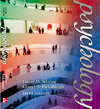 |  Psychology, 5/e Lester M. Sdorow,
Arcadia University
Cheryl A. Rickabaugh,
University of Redlands
Sensation and Perception
Learning ObjectivesAfter studying this chapter, you should be able to: - Distinguish between sensation and perception, explaining how prosopagnosia offers insight into the distinction between these two processes.
- Describe the general process by which sensation occurs in any sense modality, explaining the role of sensory receptors in sensory transduction.
- Describe the domain of psychophysics, and then explain the concepts of absolute threshold, including signal detection and subliminal stimulation, and difference threshold (jnd).
- Define and offer examples of sensory adaptation.
- Explain the physical basis of our sense of vision, noting our sensitivity to only the visible spectrum, and the significance of the amplitude, brightness and saturation of a light.
- Draw a diagram of the eye, labeling its structures and delineating their functions regarding vision, then trace the process by which vision occurs, from transduction in the retina to its final interpretation and organization in the visual cortex.
- Explain the difference between myopia and hyperopia.
- Explain the importance of smooth pursuit movements.
- Describe the importance of photoreceptors, and how they relate to the processes of dark adaptation and color vision.
- Compare and contrast the important features of the Young-Helmholtz theory of color vision with Hering’s opponent-process theory, noting how this second theory explains the phenomenon of the sex-linked characteristic of color blindness.
- Explain the difference between the contructionist theory and the direct perception theory.
- Distinguish between top-down processing and bottom-up processing in relation to figure-ground perception.
- List, describe, and offer examples of the Gestalt principles of perceptual organization, noting the disagreement among those who support the Gestalt position and those who support the feature-detector theory.
- List and describe the binocular and monocular cues for depth perception, and then explain how three types of perceptual constancies allow us to maintain stability in our perceptions.
- Describe the process by which illusions are created, and summarize the controversy that surrounds the nature of the moon illusion and the Müller-Lyer illusion.
- Summarize the findings of the classic study of the effects of early experience on the development of neural pathways, and relate this to current findings on this issue.
- Describe the effects of culture on perception.
- Describe the main properties of sound waves, explaining how they affect perceived pitch and loudness.
- Label a diagram of the auditory system, designating the outer, middle, and inner ear, and delineating the functions of its various structures, and then trace the path of an auditory stimulus from the tympanic membrane to its final interpretation in the auditory cortex.
- List and describe the four factors involved in auditory perception, mentioning the significance of place theory, frequency theory, and volley theory as well as the types of deafness.
- Summarize what is known about the process of olfactory perception and how it differs from the other sensory processes, emphasizing the strong emotional impact of certain odors, and mentioning the significance of pheromones on the sexual behavior of animals.
- Label a diagram of the tongue indicating the location of the taste buds and the location of papillae more sensitive to particular tastes, distinguishing between taste and flavor.
- List the three skin senses and describe the processes of touch and nocioception, mentioning gate-control theory and how endorphin secretion affects our perception of pain.
- List and describe five techniques for reducing pain and summarize the findings regarding how these techniques work.
- List and describe the two body senses, mentioning where the relevant sensory receptors are located in the body, and how knowledge about the vestibular sense has been applied to reduce motion sickness. (p. 169-170)
- Define parapsychology and the four main types of ESP.
- Explain why psychologists remain skeptical regarding claims of ESP, describing the current status of parapsychology.
|
|



 2002 McGraw-Hill Higher Education
2002 McGraw-Hill Higher Education

 2002 McGraw-Hill Higher Education
2002 McGraw-Hill Higher Education